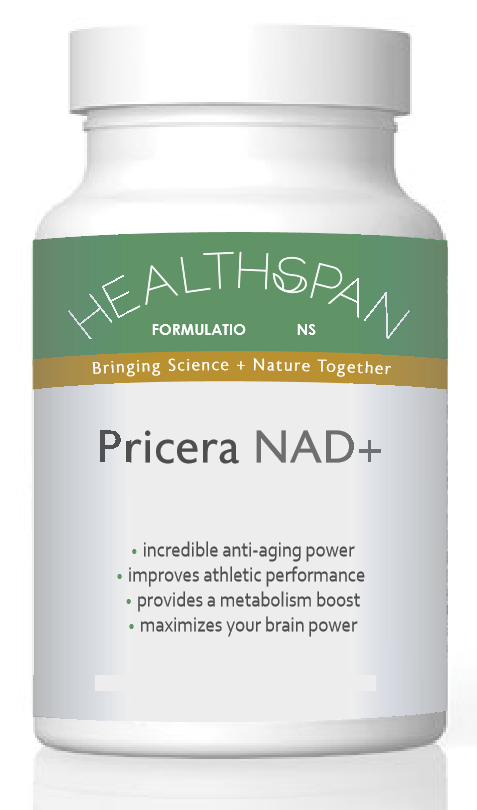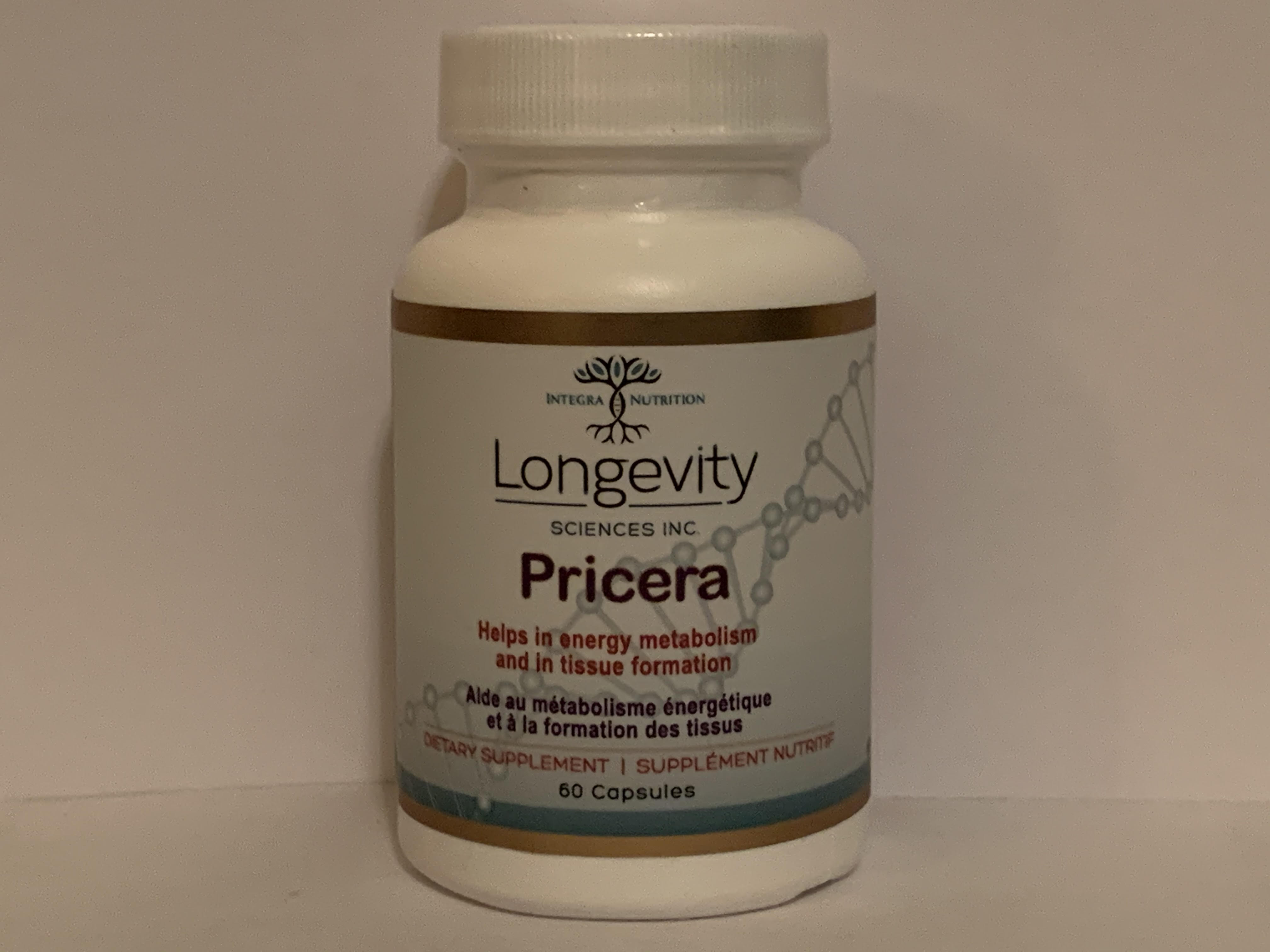NAD+ – Nicotinamide Adenine Dinucleotide is a co-enzyme present in every cell in the body and it is vital for cellular function.
Like hormones and other endogenous compounds in the body, NAD+ levels decrease as we age however they decrease precipitously with NAD+: down 50% at the age of 50 and down 90 – 96% at the age of 80.
One of the key functions of NAD+ is to activate the Sirtuin longevity genes which as the name implies are important for healthy aging. Without adequate levels of NAD+ to activate the Sirtuin genes, vascular aging accelerates.
We can help to optimize our NAD levels as we age by engaging in exercise and as well by fasting.
Another way to optimize NAD+ levels is to take a precursor formulation.
Taking NAD+ itself is not effective because it gets broken down in the digestive system.
Optimizing NAD+ levels as we age has been shown to provide many health benefits including:
KEY APPLICATIONS
• Neurodegenerative conditions e.g. Parkinson’s
• Inflammation
• Addictions
• Chronic Fatigue Syndrome
• Exercise performance and recovery
• Immune system activation
• Diabesity Spectrum
•Mitochondrial dysfunction
• Hypertension
• Elevated cholesterol levels
• Depression
• Oxidative stress
For more information on NAD+, the Sirtuin longevity genes and NAD+ precursor formulations such as our top selling practitioner quality Pricera formulation reach out to me – or review some of the info on our website:
https://roblamberton.com
Or in the following document on Pricera:
https://lnkd.in/gxS9RJDv
Category: Exercise
Is Mitochondrial Dysfunction the Cause of All Mental Illness?
Written by Rob on . Posted in Anti-aging, Brain Health / Conditions, Cardiovascular Health, Diet, Disease Conditions, Exercise, Health News. Leave a Comment
I just listened to a very interesting podcast – Tim Ferriss was interviewing a Harvard affiliated psychiatrist – Chris Palmer.
The podcast overview is as follows:
Chris Palmer, MD, of Harvard Medical School — Optimizing Brain Energy for Mental Health, The Incredible Potential of Metabolic Psychiatry, Extraordinary Case Studies, and Harnessing Mitochondria for Anxiety, Depression, OCD, PTSD, and More
Chris is a big proponent of the ketogenic diet and he has seen some dramatic improvements in the condition of some of his patients once they adopted the diet.
What I found particularly fascinating about the podcast was his hypothesis that all mental health issues can be related to a metabolic cause – specifically mitochondrial dysfunction (and he discusses other factors such as diet and exercise).
Pricera/NAD+ Highight
Optimizing NAD+ levels as we age is critical for mitochondrial function
NAD+ Treatment for Mitochondrial Dysfunction
https://advancedcryonyc.com/nad-treatment-for-mitochondrial-dysfunction
For more information on Pricera, here is a link
Prescription drugs for mental health issues can have significant negative effects on health: weight gain, the development of blood sugar issues and diabetes, cognition issues mitochondrial dysfunction and more.
It’s a fascinating concept and it reinforces even more the central role that the mitochondria play in overall health – and as Chris suggests in mental health.
Here is a link to Chris’s website – there are lots of articles and published papers links.
From his website here are a few key published papers:
Medical Journals
Norwitz NG, Dalai SS, Palmer CM. Ketogenic diet as a metabolic treatment for mental illness [published online ahead of print, 2020 Aug 6]. Curr Opin Endocrinol Diabetes Obes. 2020;10.1097/MED.0000000000000564. doi:10.1097/MED.0000000000000564 VIDEO ABSTRACT: https://cdn-links.lww.com/permalink/coe/a/coe_2020_07_08_palmer_med270505_sdc1.mp4
Zoltán Sarnyai, Christopher M Palmer, Ketogenic Therapy in Serious Mental Illness: Emerging Evidence, International Journal of Neuropsychopharmacology, , pyaa036, https://doi.org/10.1093/ijnp/pyaa036
Sarnyai Z, Kraeuter AK, Palmer CM. Ketogenic diet for schizophrenia: clinical implication. Current Opinions in Psychiatry. 2019 Sep;32(5):394-401. doi: 10.1097/YCO.0000000000000535.
Palmer CM. Diets and Disorders: Can Foods or Fasting Be Considered Psychopharmacologic Therapies? Journal Clinical Psychiatry. 2019 Jul 9;81(1). doi: 10.4088/JCP.19ac12727.
Palmer CM, Gilbert-Jaramillo J, Westman EC. The ketogenic diet and remission of psychotic symptoms in schizophrenia: Two case studies. Schizophrenia Research. 2019 Jun; 208:439-440. doi: 10.1016/j.schres.2019.03.019. Epub 2019 Apr 6.
Gilbert-Jaramillo J, Vargas-Pico D, Espinosa-Mendoza T, Falk S,
Llanos-Fernández K, Guerrero-Haro J, Orellana-Román C, Poveda-Loor C,
Valdevila-Figueira J, Palmer CM. The effects of the ketogenic diet on psychiatric symptomatology, weight and metabolic dysfunction in schizophrenia patients. Clinical Nutrition and Metabolism. July 31, 2018. Volume 1(1): 1-5. doi: 10.15761/CNM.100010
Palmer CM. Ketogenic diet in the treatment of schizoaffective disorder: Two case studies. Schizophrenia Research 2017 Nov;189:208-209. doi: 10.1016/j.schres.2017.01.053. Epub 2017 Feb 3.
CELL DANGER RESPONSE: NEW INSIGHT INTO THE CAUSE OF CHRONIC DISEASE
Written by Rob on . Posted in Anti-aging, Bacteria, Viruses, Fungi, Parasites, Blood Sugar, Brain Health / Conditions, Cardiovascular Health, Diet, Digestion / Gut Health, Disease Conditions, Environmental Toxins, Exercise, Female Conditions / Issues, Health News, Male Conditions / Issues, Pain / Inflammation, Sexual Health, Toxins. Leave a Comment
Ronald Peters, MD, MPH
I want to share with you today an article written by Ronald Peters, MD, MPH which gives an overview of a mechanism in the body which is activated when there is a perceived threat which could be viral, bacterial, toxic chemicals and metals etc. called: “The Cell Danger Response”.
Practitioners are familiar with the typical protective reactions that get activated in these situations, however where problems can arise is when this activation is not turned off after the threat has disappeared. It is suggested that this can contribute to the development of chronic, degenerative disease processes.
This concept was originally hypothesized by Robert K. Naviaux in the published paper:
Metabolic features of the cell danger response, Robert K. Naviaux, Mitochondrion 16 (2014) 7–17 The Mitochondrial and Metabolic Disease Center, University of California, San Diego School of Medicine
It has started to gain a lot of traction within the Functional Medicine community and I would suggest it certainly warrants some consideration with respect to how we approach working with patients.

You and I are wired to escape danger by automatically firing the sympathetic nervous system so we can run away or fight to survive. However, for the trillions of cells within our bodies, it is not so simple. They cannot run away. They are programmed to survive dangerous invaders such as viruses and bacteria, toxic chemicals and metals such as mercury by activating the Cell Danger Response, or CDR. Two key features of the CDR are reduced energy production (ATP) in the mitochondria and the release of inflammatory cytokines. Once the threat is eliminated the CDR is witched off and energy production starts again, and we resume our normal lives. However, sometimes the CDR does not stop and we stay fatigued and inflamed. This pathological persistence of the CDR is believed to be a primary cause for many chronic diseases including autism, PTSD, chronic fatigue syndrome, rheumatoid arthritis and many more. In this article I will review the cell danger response, what turns it on, and, importantly, how you can turn it off once the danger has passed.
CELL DANGER RESPONSE – AN ANCIENT SURVIVAL SYSTEM
Dr Robert Naviaux at the University of California, San Diego School of Medicine has reviewed the choreography of micro-events that occur as the cells and organs of the body prepare to survive threats, such as invading viruses, bacteria, fungi and parasites, or, toxic chemicals and heavy metals like mercury, lead and aluminum, as well as excessive heat or radiation. Mitochondria are the powerhouses within our cells as they use oxygen to convert chemical energy from the foods we eat into an energy form that the cell can use, which is called ATP. There are thousands of mitochondria in our cells and they orchestrate the cell danger response, which includes the following:

In response to viral attack, mitochondria sound the alarm and reduce voltage and energy production to prevent the virus from hijacking DNA to make more viruses.
Intracellular attack releases mitochondrial proteins and ATP which sound the alarm to attract other immune cells to attack the invader.
Mitochondria reduce oxygen utilization (less ATP) and reactive oxygen species along with increased hydrogen peroxide are toxic to viruses and support the cell defense.
Bacterial endotoxins activate an enzyme within the mitochondria which decreases vitamin D, thus increasing inflammation, but raising the risk for autoantibodies, especially to the thyroid gland (Hashimoto’s thyroiditis).
Under the oxidizing conditions of the CDR, methionine metabolism is shifted to assist with the production of antimicrobial reactive oxygen species as well as other antiviral and antimicrobial compounds.
De-methylation of histones is stimulated by oxidizing conditions of the CDR to increase pro-inflammatory cytokines such as TNF alpha.
Sulfur metabolism within cells is shifted to create more glutathione for macrophages and to increase glutathione transport into the brain.
CDR stimulates an enzyme which produces histamine, a potent vasodilator which facilitates the delivery of increased oxygen and immune cells to sites of inflammation.
Arginine metabolism is shifted within mitochondria to create nitric oxide (NO) gas which inhibits mitochondrial energy production.
Damaged cells release hemoglobin and heme into the tissues which stimulates the production of carbon monoxide, a potent inhibitor mitochondrial ATP production.
Cell danger increases lipoxygenase which leads to cell wall peroxidation and stiffening of cells walls in the vicinity of the threat.
Tryptophan metabolism is shifted to increase kynurenic acid which induces IL-6 and inflammatory cytokine, as well as increasing many aspects of immune function.
Toxic metals like mercury, as well as some chemicals will try to steal electrons and the mitochondria respond by reducing cellular energy production to shield the cell from further injury.
Intracellular conditions produced by the CDR lead to sequestration, or accumulation of toxic metals such as mercury, lead, cadmium, aluminum, arsenic and others, as well as reduced elimination,
When functional vitamin D is decreased by a chronically active CDR, magnesium is lost from the cells.
GUT MICROBIOME IS ESSENTIAL TO HEALTHY CDR

According to Dr. Naviaux, “healthy metabolism acts as a survival engine that computes the optimum chemical solution for fitness based on the developmental history, current environmental conditions, and the genetic resources available to the individual.”
Metabolism is all of the chemical reactions that occur in the cells of the body. Billions are occurring every second to respond to the surrounding environment in order to sustain life and they are intricately dependent on the health of the microbes that live in your body, or, microbiome. Since there are more bacterial in your body than cells, they have evolved to act as a “living shield to protect us from opportunistic pathogens and keep us healthy”.
About 99% of the bacteria in your body reside in your gut, consisting of 3,000 to 30,000 species which provide a metabolic and genetic diversity which far exceeds that of the human host.
Again, according to Dr. Naviaux, “the composition and function of the microbiome are best considered as an ecosystem that is continuously shaped by the developmental history, diet, health and activity of the host.” Basically, when the host is sick, the microbiome is also sick. The chronic activation of the CDR changes the ecosystem in the bowel and perpetuates disease in some people
RESOLUTION OF THE CDR
Once the danger or threat is eliminated, the CDR is turned off by a series of anti-inflammatory messages, normal mitochondrial energy is re-established, and normal cell life begins again.
However, based on genetic predisposition and the intensity and magnitude of the dangerous exposure a dysfunctional and persistent CDR can occur which is the precursor of many chronic diseases.
According to Dr. Naviaux, the following diseases result from a pathological persistence of the CDR:
- autism spectrum disorders (ASD),
- attention deficit hyperactivity disorder (ADHD),
- food allergies,
- asthma,
- atopy,
- emphysema,
- Tourette’s syndrome,
- bipolar disorder,
- schizophrenia,
- post-traumatic stress disorder (PTSD),
- traumatic brain injury (TBI),
- chronic traumatic encephalopathy (CTE),
- suicidal ideation,
- ischemic brain injury,
- spinal cord injury,
- diabetes,
- kidney, liver, and heart disease,
- cancer,
- Alzheimer and
- Parkinson disease,
- autoimmune disorders like lupus, rheumatoid arthritis, multiple sclerosis,
- primary sclerosing cholangitis.
According to Dr. Naviaux, each of the metabolic features of the CDR listed above “can be addressed individually with specific treatments, or more globally with a combination of supplements, dietary and activity changes, or with adaptogen therapies.”
I would add the following to the list:
- Chronic fatigue syndrome
- Irritable bowel syndrome
- Fibromyalgia
- Lyme’s disease
- Mold related illness
- Multiple chemical sensitivity
- Chronic Inflammatory Response Syndrome
- “Brain fog”
SUMMARY – CELL DANGER RESPONSE
Naviaux and other researchers have found the cell danger response is triggered by various types of environmental stressors:
- Biological stressors such as viruses, bacteria, fungi such as mold, parasites and more
- Chemical stressors such as toxic chemicals and heavy metals (e.g. mercury and lead)
- Physical trauma such as an accident, burn, surgery, or physical abuse
- Psychological trauma that creates overwhelm and persistent despair, such as the loss of a loved one, divorce, financial struggle, childhood emotional neglect
As Naviaux explains, these are triggers of illness, but they are not the cause of disease. As he presented to the Open Medicine Foundation on 9/28/2017, they all “ring the same bell – the cell danger response. “ In this new paradigm of disease, symptoms arise because a cell danger response gets stuck in the “on” position and can’t complete its healing cycle to turn itself back off as it is designed to do.
“In most cases of persistent chronic illness lasting for > 3–6 months, mitochondria are not dysfunctional. They are just stuck in a developmental stage that was intended to be temporary, unable to complete the healing cycle”
Robert Naviaux, Mitochondrion 46, 2019
TURNING OFF THE CELL DANGER RESPONSE – CONSCIOUSNESS AS THE SOURCE AND CURE FOR DISEASE
Illness gives patients temporary permission to act in more open ways emotionally. But if they cannot learn to give themselves that same permission when they are healthy, then the moment they get well, the old rules again apply, and they find themselves in the psychologically and physically destructive situation that first contributed to their illness.
Carl Simonton, MD

The cell danger response is turned on by dangers perceived at the cellular level, or, by dangers perceived by the individual in their life experience. Dr. Naviaux has described the cellular events that initiate the CDR. And we all have experienced threatening or frightening life events. The horrors of war can be overwhelming and a soldier will often suppress the intense emotions and later develop PTSD. For the abused or abandoned child, strong emotions are automatically suppressed, only to be stored in the unconscious mind as an emotional wound. These wounds will surface later in life and contribute to dis-ease of one kind or another. In both cases the CDR is ignited by the powerful “fight or flight” sympathetic nervous system as it births anger, fear and panic.
In order to turn off the CDR, once the danger has passed, we need to understand ourselves and how we create stress and handle emotions. Extensive medical research also shows that digestion, blood circulation, immune activity, hormone levels are but a few of the systems controlled by the mind. Dr. Candace Pert, the NIH researcher who discovered neurotransmitters, said it simply: “The more I look, (at the immune system) the more I’m convinced that emotions are running the show.”
Basically, we need to heed the “message of illness” and consider the dysfunctional beliefs and suppressed emotional pain that are expressed within the fabric of your body as dis-ease. Mindbody medicine is the science of healing at the level of consciousness and represents the next step in healthcare. It is based on the disturbing and eternal truth that the body is governed by consciousness (both conscious and unconscious).
Mindbody medicine will help you learn the following:
- The natural intelligence of your body is governed by consciousness.
- The function of the sympathetic nervous system (SNS) which is activated by fear, worry, anger and frustration.
- How to enhance your parasympathetic nervous system (PNS), which governs your immune system, proper digestion, and hormone production.
- The nature of the stressful life experiences which precede illness and how they can be tracked back to childhood experiences.
- Adverse Childhood Experiences (ACE) and how they compare to Post-traumatic Stress Disorder (PTSD).
- What is the “limbic lock” associated with chronic disease?
- How to create a healthy gut microbiome, which is required to quiet the CDR and enhance vagal activity.
- How to find the personal meaning of disease.
- How reduce stress and live from your heart, the seat of emotion, love, intuition, and “seeing the big picture”.
- All dis-ease is a personal invitation for healing, growing and gaining self-knowledge, by making the unconscious mind conscious.
- The “blessing” of the dis-ease in any area of your life as well as your body offers you a window into the stored pain in the unconscious mind and how it can be discharged thereby leading to greater levels of peace and happiness.
- How to activate the powerful vagus nerve which turns off the SNS and CDR.
Is This the Key to Managing Sarcopenia?
Written by Rob on . Posted in Anti-aging, Brain Health / Conditions, Cardiovascular Health, Disease Conditions, Exercise, Health News. Leave a Comment
Sarcopenia is recognized as an issue related to the aging process and/or immobility.
From Wikipedia, here is a description of sarcopenia:
Sarcopenia is a type of muscle loss (muscle atrophy) that occurs with aging and/or immobility. It is characterized by the degenerative loss of skeletal muscle mass, quality, and strength. The rate of muscle loss is dependent on exercise level, co-morbidities, nutrition and other factors. The muscle loss is related to changes in muscle synthesis signalling pathways. It is distinct from cachexia, in which muscle is degraded through cytokine-mediated degradation, although both conditions may co-exist. Sarcopenia is considered a component of frailty syndrome.[1] Sarcopenia can lead to reduced quality of life, falls, fracture, and disability.[2][3] Obviously, remaining active as we age is a key cornerstone to optimal health however there are additional factors at play which can be modified to help to maintain muscle mass and strength/power.
In a paper published in the journal Nature Aging, it suggests that maintaining optimal NAD+ levels can be a significant factor in maintaining metabolic and physical function.
NAD+ levels decrease precipitously as we age: by the age of 50, it is down 50% and by the age of 80 it is down 90 – 96% so it is essentially gone.
One of the key functions of NAD+ is to activate the Sirtuin Longevity Genes which as the name implies are critical to healthy aging.
If these genes are not activated, it accelerates vascular aging.
If you have not yet experienced the wonders and benefits of NAD+ optimization by consuming our Pricera NAD+ precursor formulation, reach out to me.
Following is the abstract:
Healthy aging and muscle function are positively associated with NAD+ abundance in humans
- Georges E. Janssens,
- Lotte Grevendonk,
- Ruben Zapata Perez,
- Bauke V. Schomakers,
- Johan de Vogel-van den Bosch,
- Jan M. W. Geurts,
- Michel van Weeghel,
- Patrick Schrauwen,
- Riekelt H. Houtkooper &
- Joris Hoeks
Nature Aging volume 2, pages 254–263 (2022)
Abstract
Skeletal muscle is greatly affected by aging, resulting in a loss of metabolic and physical function. However, the underlying molecular processes and how (lack of) physical activity is involved in age-related metabolic decline in muscle function in humans is largely unknown.
Here, we compared, in a cross-sectional study, the muscle metabolome from young to older adults, whereby the older adults were exercise trained, had normal physical activity levels or were physically impaired. Nicotinamide adenine dinucleotide (NAD+) was one of the most prominent metabolites that was lower in older adults, in line with preclinical models.
This lower level was even more pronounced in impaired older individuals, and conversely, exercise-trained older individuals had NAD+ levels that were more similar to those found in younger individuals. NAD+ abundance positively correlated with average number of steps per day and mitochondrial and muscle functioning. Our work suggests that a clear association exists between NAD+ and health status in human aging.
Why Optimizing NAD+ Levels is Critical for Healthy Aging
Written by Rob on . Posted in Anti-aging, Blood Sugar, Brain Health / Conditions, Cardiovascular Health, Digestion / Gut Health, Disease Conditions, Exercise, Female Conditions / Issues, Health News, Male Conditions / Issues, Pain / Inflammation, Vitamins, Minerals, Herbs. Leave a Comment
Pricera our NAD+ precursor formulation is now available!
Why maintaining optimal NAD+ levels as we age is critical to our quality of life, healthspan and potentially lifespan
I wanted to share with you today why I believe that maintaining optimal NAD+ levels is critical for healthy aging, extending healthspan – and potentially lifespan (as has been shown in animal studies).
“In my opinion, NAD therapy will turn out to be one of the greatest advances in medical science since Fleming developed penicillin”.
Dr. Phil Milgram, MD
NAD+ levels decrease with age:
- People aged 50 have about 40% less NAD+
- By the age of 80 years, NAD+ levels decline between 90-98%

NAD+ and the Sirtuin Longevity Genes
Optimal NAD+ levels are critical for the activation of the Sirtuin longevity genes.
Limited Sirtuin longevity gene activity can lead to an acceleration of the aging process: one example of this is vascular aging.
Vascular aging is responsible for a constellation of disorders, such as cardiac and neurologic conditions, muscle loss, impaired wound healing and overall frailty, amongst others.
Multiple animal studies have demonstrated that increasing sirtuin activity leads to:
•Longer life
•Less age-related loss of function
•Less DNA damage
NAD+ maintains and builds sirtuin levels and activity
Exercise Performance
Another impressive benefit of optimizing NAD+ levels is in the area of exercise:
In a mouse study, the cohort which was supplemented to optimize NAD+ levels it increased their exercise capacity between 56 and 80 percent, compared with untreated mice.
David Sinclair, PhD commented about the results of this study:
“Even if you’re an athlete, you eventually decline,” Sinclair said. “But there is another category of people—what about those who are in a wheelchair or those with otherwise reduced mobility?”
In another study involving elderly men, supplementation with an NAD+ precursor resulted in improved exercise performance:
The men in this study had an 8% improvement in peak isometric muscle torque (a measure of muscle force) and a 15% improvement in fatigue associated with exercise.
Other Research Highlights:
• Boosting NAD+ biosynthesis by using key NAD+ intermediates is now drawing significant attention for: Alzheimer’s/Type 2 Diabetes/Heart Failure/ Hearing Loss
• NAD+ precursors have been shown to increase stem cell colonies by 75% in the gut of aging mice
• Other studies point to the role of NAD+ in restoring circadian rhythms needed for restorative sleep
• SirT1 overexpression protects against Alzheimer’s and Huntington’s disease as well as ALS
Low NAD+ Levels Can Contribute to the Following:
•Accelerates aging
•Increases sunburn and skin cancer
•Decreases cellular antioxidants
•Decreases metabolism along with thyroid hormones
•Harms immune function
•Increases inflammation
•Impairs brain function
•Can cause hypoxia intracellularly
•Associated with Chronic Fatigue Syndrome
•May worsen weight gain and metabolic syndrome
•May worsen cardiovascular diseases
May contribute to MS (multiple sclerosis)
Why Is It Important to Increase NAD+ Levels?
General Benefits
•Low NAD+ levels can accelerate the aging process
•NAD+ is vital for mitochondrial health
•NAD+ plays a key role in cellular metabolism and energy production
•NAD+ is a rate-limiting co-substrate for sirtuins
•High NAD+ levels are essential for DNA repair and recovery
•NAD+ activates CD38, which is present on many immune cells (white blood cells) and associated with impaired immune responses.
•Enhances autophagy
•Helps maintain redox potential
Specific Conditions
•Positive impact on the Diabesity Spectrum
•Low NAD+ levels may worsen cardiovascular diseases
•Low NAD+ levels may increase inflammation

In my opinion, you cannot age well and extend healthspan without addressing and maximizing NAD+ levels, especially with older patients.
For more information about Pricera or where you can get some reach out to me.
Copyright © 2020 Robert Lamberton
All rights reserved
Health Conditions Which Can Benefit From Increased NAD+ Levels:
•Alcoholism
•ALS
•Alzheimer’s Disease
•Anxiety
•Benzo Addiction
•Brain Injury
•Cancers
•Chronic Fatigue
•Depression
•Diabesity Spectrum
•Elevated cholesterol levels
•Fibromyalgia
•Hypertension
•IBS
•Immune system activation
•Inflammation
•Lyme’s Disease
•Malabsorption Syndrome
•Methadone Addiction
•Mitochondrial Dysfunction
•Multiple Sclerosis
•Narcotic Addiction
•Neurodegeneration
•Oxidative stress
•Parkinson’s Disease
•PTSD
•Respiratory Allergies
•Schizophrenia
•SIBO
•Skin Allergies
•Stress
Debunking the Game Changers Documentary
Written by Rob on . Posted in Anti-aging, Blood Sugar, Brain Health / Conditions, Cardiovascular Health, Diet, Digestion / Gut Health, Disease Conditions, Exercise, Female Conditions / Issues, Health News, Male Conditions / Issues, Pain / Inflammation, Vitamins, Minerals, Herbs. Leave a Comment
A recent documentary viewed by many suggested that a plant based – vegan diet is the optimal diet for athletes.
What Is The Game Changers?
The Game Changers is an agenda-driven film, not an objective analysis of an optimal diet for athletes. The purpose of this film is to advocate for a plant-based diet. It hasn’t been peer-reviewed, and it plays very fast and loose with the science. It’s propaganda for veganism, pure and simple.
This is a very slick, well-done film, and it has the potential to mislead a lot of people. But it’s full of misleading statements, half-truths, flat-out falsehoods, flawed logic, and absurdities.
Chris Kresser of ChrisKresser.com did a great rebuttal of this documentary – both live on two podcasts on the Joe Rogan show as well as in writing.
Below is a portion of his written comments.
The documentation is quite extensive so if you want to review it in detail here is the link.
As a health care practitioner dealing with clients to help them with their health issues I will suggest that a vegan diet typically ends up over time in causing negative health issues, typically due to vitamin and mineral deficiencies.
My experience is similar to most health care practitioners whom I ask about this topic.
No one diet is optimal for everyone!
Determining an optimal diet is best done by working with a knowledgeable health care practitioner such as an integrative/Functional Medicine MD, ND, DC, RD, nutritionist etc.
Here is the initial part of Chris’s written rebuttal to The Game Changers documentary.
What is the optimal diet for athletes? While I don’t believe there is one optimal diet for every person, I do think there are characteristics that all healthy diets share. Namely, they’re ancestral—based on the types of foods that our bodies evolved to thrive on—and they include a mix of nutrient-dense plant and animal foods.
A recent documentary called The Game Changers claims otherwise. The experts and celebrities featured in the film argue that a plant-based, vegan diet is optimal for athletes and that animal foods are harmful for athletic performance and overall health.
There are a lot of myths and misconceptions on this topic, so I wanted to take this opportunity to debunk some of the biggest claims made in The Game Changers. For a full breakdown of what this movie gets wrong, download my Show Notes, and listen to my appearance on The Joe Rogan Experience.
I’ve conducted extensive research on the real impact of a plant-based diet over an omnivorous, ancestral diet. I’m sharing that research with you now in hopes that it helps clear up some of the misconceptions on vegan diets.
What Is The Game Changers?
The Game Changers is an agenda-driven film, not an objective analysis of an optimal diet for athletes. The purpose of this film is to advocate for a plant-based diet. It hasn’t been peer-reviewed, and it plays very fast and loose with the science. It’s propaganda for veganism, pure and simple.
This is a very slick, well-done film, and it has the potential to mislead a lot of people. But it’s full of misleading statements, half-truths, flat-out falsehoods, flawed logic, and absurdities. I found problems with a number of claims made in the movie, including:
- The gorilla analogy
- The idea that peanut butter has as much protein as beef or eggs
- The gladiator diet
- The impact of protein on strength and health
- Where B12 comes from
These are examples of some very misleading and disingenuous uses of science.
- 1
- 2




